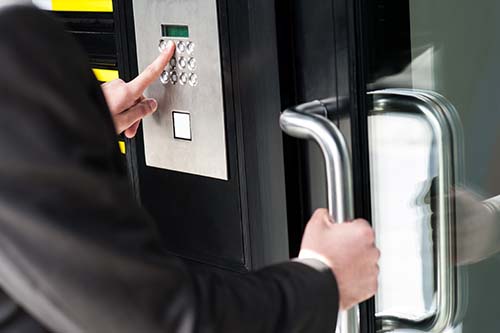What is an access control system?
An access control system is the selective restriction of access to a place or other resource. Authorizations are put into place to give permission to those resources. This can be consuming, entering or using a resource. Locks and login credentials are to of the most common types of access control systems.
Physical Security
Access control restricts entrance to a property, a building, or a specific room for authorized personnel only. Entrance into your business facility can be monitored in many ways:
- Border Guard
- Bouncer
- Ticket checkers
- Turnstile or fence
- Maintrap
Turnstiles
Many large venues like sporting arenas commonly use a combination of security strategies like ticket checkers along with turnstiles. Turnstiles are also known as baffle gates. It is a form of gate which allows only one person to pass through at a time. They are also utilized to enforce the one-way traffic of people. Sometimes turnstiles only allow passage with the use of a ticket, coin or ID badge.
- Stadiums
- Amusement Parks
- Mass Transit Stations
- Office Lobbies
- Airports
- Ski Resorts
- Factories and Power Plants
- Casinos
Maintraps
A maintrap is also referred to as an air lock system, sally port or access control vestibule. They are a physical security access control system comprising of a small space between two sets of interlocking doors. One set of doors must close fully before the second set will open.
If your business is utilizing a manual maintrap, a security guard is needed to lock and unlock the two sets of doors. In most cases an intercom or video camera is used for the guard to operate the mantrap from a remote location.
For an automatic maintrap, identification is often required to open each door. Depending on the security level, there may be other measures needed to gain entry such as fingerprint or retina scanning.
Metal Detectors are often built into an entrance system. This is obviously great for reducing the risk of people entering with weapons. Banks and jewelry stores are perfect candidates for metal detectors.
Components of an Access Control System
- Physical Barrie/Access Point (door with lock)
- Reader or Keypad
- Control Panel to verify identification
- Request to Exit Button (REX)
Technology
Access decisions are made by comparing the credential to an access control list of verified personnel. This can also be done through a reader.
Types of Readers
- Basic (non-intelligent) readers simply read card numbers of PIN numbers which are forwarded to a control panel.
- Semi-intelligent readers do not make any access decisions. They consist of all the necessary functions to control the access point hardware (the door, the lock, and exit button) This reader will read a PIN or badge number and automatically lock or unlock the access door.
- Intelligent Readers can control all aspects of the access door’s hardware while having the ability to make access decisions independently.
Access Point Security Risks
Tailgating
The biggest risk with these types of security points is “tailgating”. Tailgating is when one person simply follows another closely through the access gate or door into a restricted area. This risk is minimized through security awareness and training. At highly populated access points, maintraps and turnstiles are the best deterrents of tailgating.
Door Levering
Levering a door open is another common security risk with physical access points. This is more difficult to do on properly secured doors which are usually much more heavy with magnetized locking systems. Fully equipped access control systems will have a door alarm which will sound when the door is left open for a certain period of time. Most up to date systems will have a door prop alarm to inform system administrators about the open door. This minimizes false alarms and poor database configuration.
Access Card Tampering
Access cards themselves have proven vulnerable over the years. Many sophisticated hackers have been known to build portable readers to capture proximity card information. All the hacker would need to do is walk closely to the cardholder to obtain their valuable information on their reader. To counter this risk, many times businesses will require a two part authentication. The member of personnel must swipe their card AND enter a PIN or give a fingerprint.

